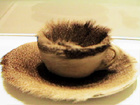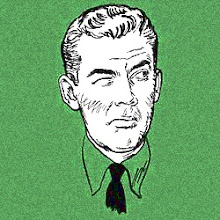 The photo at left shows Hemingway with Fidel Castro in 1960. But for now let's talk about Hem's poems. Yes, poems.
The photo at left shows Hemingway with Fidel Castro in 1960. But for now let's talk about Hem's poems. Yes, poems.Over the years there have been nine unauthorized editions of the poems. All or most of these editions contain 18 poems, which are most of the poems Hem wrote and published while he was living in Paris in the 1920s. The critical response to his verse is mostly based on the pirated editions, which are filled with errors.
One of these unauthorized editions was published by City Lights in San Francisco in 1960. It sold for 50 cents. We have not been able to find any reviews of this edition at all. (The edition of Hem's poems to consult is Nicholas Gerogiannis's Nebraska edition of 1992, 171 pages in length.) The City Lights book is 28 pages.
 The bio note in Poetry for January 1923 calls Hem "a young Chicago poet now abroad, who will soon issue his first book of poems." Edmund Wilson quipped that these "are not particularly important" but they do show the writer moving in the main poetic current of the time, at least very generally: what might be called precise yet poignant discernment.
The bio note in Poetry for January 1923 calls Hem "a young Chicago poet now abroad, who will soon issue his first book of poems." Edmund Wilson quipped that these "are not particularly important" but they do show the writer moving in the main poetic current of the time, at least very generally: what might be called precise yet poignant discernment.He tried to spit out the truth;
Dry-mouthed at first,
He drooled and slobbred in the end;
Truth dribbling his chin.
Seems like a bad page in a Nick Adams story, lineated.






 Is '60 the moment when the end of the end of the Old Left had been reached and the New Left began to emerge? Is it the final ascendancy, in certain scenes at least, of poetic postmodernity? Surely the publication of Donald Allen's The New American Poetry that year suggests this, but then again--once again--we look back on "New" here and see continuity. The rhetoric of the Kennedy-Nixon contest made much less of a dent than everyone (at the time as well as since) claimed, so one wonders why were such great claims made?
Is '60 the moment when the end of the end of the Old Left had been reached and the New Left began to emerge? Is it the final ascendancy, in certain scenes at least, of poetic postmodernity? Surely the publication of Donald Allen's The New American Poetry that year suggests this, but then again--once again--we look back on "New" here and see continuity. The rhetoric of the Kennedy-Nixon contest made much less of a dent than everyone (at the time as well as since) claimed, so one wonders why were such great claims made?  Had we come to expect "1960" to be truly ubiquitously modern in a way that the 1950s really were not--not quite? And what specifically does "modern" mean in the Kennedyesque talk then and now about the torch being passed to a new generation, etc.? The First Lady really meant "modernist" when Camelotians said "modern." What about the others across the new young cultural leadership? I've been surprised by how frequently the
Had we come to expect "1960" to be truly ubiquitously modern in a way that the 1950s really were not--not quite? And what specifically does "modern" mean in the Kennedyesque talk then and now about the torch being passed to a new generation, etc.? The First Lady really meant "modernist" when Camelotians said "modern." What about the others across the new young cultural leadership? I've been surprised by how frequently the  "Beat movement" was covered in 1960 in the mainstream press. I was expecting a fair measure but I've found tonnage. 1960 was the year when the figure of the beat was beginning to find acceptance, although still 80% of these stories are mocking, rebels-without-cause condescension. For anyone whose analysis made an impact nationally, do these antipolitical adolescents count as part of the "new young cultural leadership"? No, but rather than the two being opposites, they fall along a Continuum of the New American. Now that's a change for '60.
"Beat movement" was covered in 1960 in the mainstream press. I was expecting a fair measure but I've found tonnage. 1960 was the year when the figure of the beat was beginning to find acceptance, although still 80% of these stories are mocking, rebels-without-cause condescension. For anyone whose analysis made an impact nationally, do these antipolitical adolescents count as part of the "new young cultural leadership"? No, but rather than the two being opposites, they fall along a Continuum of the New American. Now that's a change for '60.







